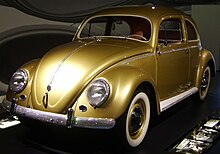Wirtschaftswunder

Wirtschaftswunder (Jerman: [ˈvɪʁt.ʃaftsˌvʊndɐ] ⓘ, "keajaiban ekonomi"), juga dikenal sebagai Keajaiban di Sungai Rhine, adalah istilah yang menjelaskan rekonstruksi dan perkembangan ekonomi Jerman Barat dan Austria yang begitu cepat setelah Perang Dunia II.[1][2] Istilah ini digunakan pertama kali oleh The Times tahun 1950.[butuh rujukan]
Hal ini dimulai dengan mengganti mata uang Reichsmark dengan Deutsche Mark (juga Schilling di Austria), kemudian diikuti dengan inflasi rendah yang bertahan lama bersamaan dengan pertumbuhan industri yang luar biasa dipimpin oleh Kanselir Konrad Adenauer dan menteri ekonominya, Ludwig Erhard.[1] Di Austria, penggunaan tenaga kerja efisien juga menjadi motor pertumbuhan ekonomi.
Era pertumbuhan ekonomi yang luar biasa ini menjadikan Jerman dan Austria dari negara yang porak-poranda akibat perang menjadi negara maju di Eropa modern. Saat berdirinya Pasar Bersama Eropa tahun 1957 pertumbuhan ekonomi Jerman berbanding terbalik dengan kondisi di Britania Raya yang tengah mengalami kesulitan.
Referensi
- ^ a b Henderson, David R. (2008). "German Economic Miracle". Concise Encyclopedia of Economics (edisi ke-2nd). Indianapolis: Library of Economics and Liberty.
- ^ Utgaard, P. (2003). Remembering and Forgetting Nazism: Education, National Identity, and the Victim Myth in Postwar Austria. New York: Berghahn Books. hlm. 126–128. line feed character di
|title=pada posisi 36 (bantuan)
Lihat pula
- Rencana Marshall
- Trente Glorieuses
- Keajaiban ekonomi Jepang setelah Perang Dunia II
Pranala luar
- Rebuilding GermanyPDF (147 KiB)
- Interview with Gunther Harkort Diarsipkan 2014-12-27 di Wayback Machine. Representative of the Federal Republic of Germany to the Economic Cooperation Administration (ECA), 1949–1952.
- Interview with General Lucius D. Clay Deputy to U.S. General Dwight D. Eisenhower, 1945; deputy military governor, Germany (U.S.) 1946; commander in chief, U.S. Forces in Europe and military governor, U.S. Zone, Germany, 1947–49; retired 1949.
- Interview with General William Henry Draper Jr. Chief, Economics Division, Control Council for Germany, 1945–1946; Military Government Adviser to the Secretary of State, Moscow Conference of Foreign Ministers, 1947; Under Secretary of War, 1947; Under Secretary of the Army, 1947–1949;
- 'Time Magazine Faceless Crisis'[pranala nonaktif permanen], April 4, 1949
- Letter from Konrad Adenauer to Robert Schuman (26 July 1949) Warning him of the consequences of the dismantling policy.
- Picture of demonstration against dismantling (7 June 1949) Workers in the Ruhr demonstrate against the dismantling of their factories by the Allied forces of occupation.
- Picture: dismantling the Iron and Steel Industry ‘We want to work, we will help you to rebuild Europe' Workers at dismantled plant protest.
- Picture: 12,000 factory workers demonstrate against the dismantling of German industry (19 August 1949)
- German Economic Miracle Diarsipkan 2015-05-10 di Wayback Machine.











